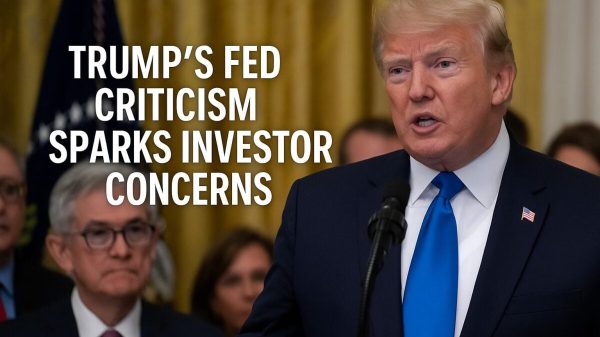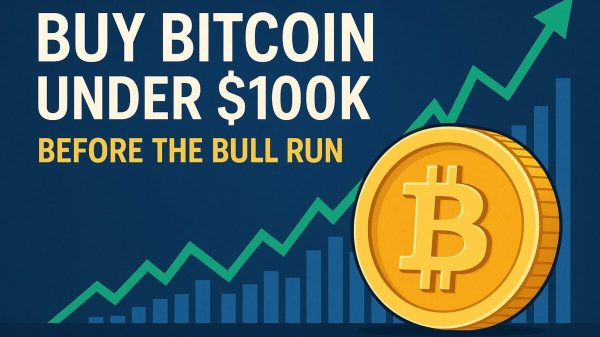AGNC Investment Corp (NASDAQ:AGNC) discussed its third-quarter 2024 financial results on [date], revealing a robust economic return of 9.3% and a stable monthly dividend. The company benefited from the Federal Reserve’s rate cut in September, which contributed to a favorable investment environment. AGNC’s net asset value per common share increased by 1.4% year-to-date, while the total stock return with reinvested dividends reached 17.5%.
Key Takeaways
AGNC maintained a monthly dividend of $0.12 per common share for 55 months.
The Federal Reserve’s rate cut in September positively influenced AGNC’s investments.
Net asset value per common share rose by 1.4% year-to-date.
Total stock return with reinvested dividends stood at 17.5%.
AGNC reported total comprehensive income of $0.63 per share for Q3.
The company’s investment portfolio expanded to $72.1 billion.
Company Outlook
The company expects mortgage rates to remain above 6.5% for an extended period.
Book value decreased by approximately 3.5% due to rising treasury rates.
AGNC maintains a strong cash position to navigate market volatility.
Bearish Highlights
The Non-Agency securities portfolio decreased slightly to $890 million.
Book value declined by about 3.5% last week due to rising Treasury rates.
Bullish Highlights
The investment portfolio grew, focusing on lower coupon Agency MBS.
The shift to treasury-based hedges and a decrease in swap-based hedges were strategic responses to the evolving yield curve.
Stable funding conditions for Non-Agency Securities and tightening credit spreads were noted.
Misses
The TBA position declined, although the Ginnie Mae TBA position remained largely unchanged.
Q&A Highlights
Management discussed strategic focus on delta hedging and potential shifts back to swap-based hedges.
Increased demand for MBS expected as the yield curve steepens with Fed easing.
Current coupon production believed to offer the best long-term risk-adjusted returns.
The company raised capital opportunistically and slowed deployment as mortgage rates approached the lower end of the range.
AGNC’s third-quarter performance was bolstered by a strategic shift towards treasury-based hedges and a focus on lower coupon Agency MBS, which outperformed higher coupons. The Non-Agency securities portfolio saw a slight decrease to $890 million, mainly due to participation in GSE tender offers. Despite a 3.5% decrease in book value attributed to rising treasury rates and upcoming election volatility, the company’s outlook remains optimistic, with a strong cash position and a strategic approach to hedging and leverage. Management anticipates a shift towards higher coupon securities and increased demand for MBS, particularly from unlevered investors, as market conditions evolve.
InvestingPro Insights
AGNC Investment Corp’s recent financial performance aligns with several key metrics and insights from InvestingPro. The company’s robust economic return and stable dividend policy are reflected in InvestingPro’s data, which shows a significant dividend yield of 13.87% as of the latest available date. This high yield supports AGNC’s commitment to maintaining its monthly dividend, which has been consistent for 55 months according to the earnings report.
InvestingPro Tips highlight that AGNC has maintained dividend payments for 17 consecutive years, underscoring the company’s long-term commitment to shareholder returns. This is particularly relevant given the article’s focus on AGNC’s dividend stability and total stock return with reinvested dividends.
The company’s positive outlook and growth expectations are corroborated by InvestingPro Tips, which indicate that net income is expected to grow this year and analysts anticipate sales growth in the current year. This aligns with AGNC’s reported expansion of its investment portfolio to $72.1 billion and the strategic focus on lower coupon Agency MBS.
AGNC’s market capitalization stands at $8.49 billion, reflecting its significant presence in the mortgage REIT sector. The price-to-book ratio of 1.21 suggests that the stock is trading slightly above its book value, which is consistent with the reported increase in net asset value per common share.
It’s worth noting that InvestingPro offers 7 additional tips for AGNC Investment Corp, providing investors with a more comprehensive analysis of the company’s financial health and market position.
Full transcript – AGNC Investment Corp (AGNC) Q3 2024:
Operator: Good morning, everyone, and welcome to the AGNC Investment Corp Third Quarter 2024 Shareholder Call. All participants will be in a listen-only mode. [Operator Instructions] Please note, today’s event is being recorded. At this time, I’d like to turn the conference call over to Katie Turlington of Investor Relations. Please go ahead.
Katie Turlington: Thank you all for joining AGNC Investment Corp’s third quarter 2024 earnings call. Before we begin, I’d like to review the safe harbor statement. This conference call and corresponding slide presentation contains statements that, to the extent they are not recitations of historical fact, constitute forward-looking statements within the meaning of the Private Securities Litigation Reform Act of 1995. All such forward-looking statements are intended to be subject to the safe harbor protection provided by the Reform Act. Actual outcomes and results could differ materially from those forecasts due to the impact of many factors beyond the control of AGNC. All forward-looking statements included in this presentation are made only as of the date of this presentation and are subject to change without notice. Certain factors that could cause actual results to differ materially from those contained in the forward-looking statements are included in AGNC’s periodic reports filed with the Securities and Exchange Commission. Copies are available on the SEC’s website at sec.gov. We disclaim any obligation to update our forward-looking statements unless required by law. Participants on the call include Peter Federico, Director, President and Chief Executive Officer; Bernie Bell, Executive Vice President and Chief Financial Officer; Chris Kuehl, Executive Vice President and Chief Investment Officer; Aaron Pas, Senior Vice President, Non-Agency Portfolio Management; and Sean Reid, Executive Vice President, Strategy and Corporate Development. With that, I will turn the call over to Peter Federico.
Peter Federico: Good morning, and thank you for joining our third quarter earnings call. For the last several quarters, we have spoken about a promising and durable investment environment that we believe was unfolding for AGNC. An environment characterized by mortgage spreads that were materially wider than historical norms, declining interest-rate volatility, and the emerging accommodative monetary policy stance by the Federal Reserve. In the third quarter, these positive trends became increasingly apparent and as a result, investor optimism grew. Against this favorable fixed-income investment backdrop, AGNC generated a very strong economic return of 9.3% in the third quarter, driven by solid book-value growth and our compelling monthly dividend, which has now remained stable at $0.12 per common share for 55 consecutive months. At its September meeting, the Fed began the process of recalibrating monetary policy with an initial rate cut that was larger than many expected. More important than the magnitude of the rate cut itself, the move marked the end of a very challenging three-year period of unprecedented monetary policy restraint. In addition, the Fed also communicated its intention to lower short-term rates to a neutral level over time. Consistent with this view, the September summary of economic projections showed the median federal funds rate declining by 250 basis points by the end of 2026. While the path to this neutral policy stance will undoubtedly depend on economic data, as Chairman Powell explicitly stated, the direction of travel is now clear. This significant transition in monetary policy marked a positive development for AGNC and for fixed-income markets broadly speaking. In response to this improved monetary policy outlook, treasury rates rallied across the yield curve with short-term rates declining significantly more than long-term rates. To put the rate moves in perspective, the yield curve ended the quarter with a positive slope for the first time in two years. Agency MBS performance during the third quarter varied considerably by coupon and hedge composition. Our performance benefited from having a diversified mix of assets as well as a meaningful share of longer-term treasury-based hedges. From a macro perspective, there were a couple of important takeaways from the third quarter. First, the long-awaited Fed pivot occurred and consistent with historical experience, the Fed is expected to return the federal funds rate to a neutral level over the next 12 months to 24 months. Typically, in such periods of monetary policy accommodation, the yield curve steepens, and the demand for high-quality fixed-income instruments like Agency MBS grows. The other important takeaway from the quarter is that Agency MBS spreads remain in the same relatively narrow trading range that has now been in place for close to a year. This trading range compares very favorably to the highly volatile spread environment that existed while the Fed was aggressively tightening monetary policy. As a levered and hedged investor in Agency MBS, AGNC’s return opportunities are most favorable when Agency MBS spreads to swap and treasury rates are wide and stable and when interest rates and monetary policy are less volatile. We anticipated that this type of environment would eventually emerge once the Fed transitioned to an accommodative monetary policy stance, which it did at the September meeting. With Agency MBS spreads trading in a relatively narrow range this year, it follows that our common stock net asset value would also be relatively stable. That has been the case with our net asset value per common share increasing a modest 1.4% over the first nine months of the year. Much more significantly, however, our economic return per common share, which includes the dividends we paid as well as the change in our net asset value was 13.8% through the first nine months of the year. Similarly, our total stock return with dividends reinvested was 17.5% over the same period. This performance exemplifies AGNC’s ability to generate very attractive returns in environments where spreads are wide and stable. Looking ahead, we believe the most likely scenario for Agency MBS spreads is that they remain in the current trading range. This view is predicated in part on our belief that the supply-and-demand dynamics for Agency MBS remain in reasonable balance. Given the recent modest decline in mortgage rates, it is possible that the supply of Agency MBS will increase somewhat over the intermediate term. On the demand side, however, accommodative monetary policy, a steeper yield curve, historically large money market mutual fund balances, and less onerous bank regulation indicate to us that the demand for high-quality fixed-income assets is biased to increase as the Fed reduces short-term interest rates. While the path of financial markets is never perfectly smooth and periods of volatility are inevitable, the outlook for Agency MBS is decidedly better today than it was in 2022 and 2023, given the current economic outlook, the stance of the Fed, and our expectation that long-term interest rates and Agency MBS spreads will remain relatively stable. With that, I will now turn the call over to Bernie Bell to discuss our financial results in greater detail.
Bernie Bell: Thank you, Peter. For the third quarter, AGNC had total comprehensive income of $0.63 per share. Economic return on tangible common equity was 9.3% for the quarter, comprised of $0.36 of dividends declared per common share and an increase in our tangible net book value of $0.42 per share or 5%. As of late last week, our tangible net book value per common share was down about 3% for October or about 3.5% after deducting our monthly dividend accrual. Leverage decreased modestly for the quarter to 7.2 times tangible equity as of quarter-end from 7.4 times as of Q2. Additionally, we concluded the quarter with unencumbered cash and Agency MBS of $6.2 billion or 68% of our tangible equity, which was up from $5.3 billion or 65% of tangible equity as of June 30. The average projected life CPR for our portfolio at quarter-end increased 4% to 13.2%, consistent with the decline in interest rates. While the average coupon in our portfolio was largely unchanged at just over 5% as of 9/30. Actual CPRs for the quarter averaged 7.3%, up slightly from 7.1% for Q2. Net spread and dollar roll income declined by $0.10 to $0.43 per common share for the quarter, driven by a reduction in our net interest-rate spread, which narrowed by approximately 50 basis points to just above 220 basis points for the quarter. About half of the decline in our net interest spread which was a result of $6.5 billion of very low-cost pay fix swaps that matured during the quarter. We have no additional swaps scheduled to mature until the second quarter of next year. The other half of the decline was due to our decision to further reduce our swap-based hedges and increase our use of treasury-based hedges, which are not captured in our reported net interest spread. Lastly, in the third quarter, we issued $781 million of common equity through our at-the-market offering program. The significant increase in ATM issuance was consistent with the substantial price-to-book premium of our common stock throughout the quarter and drove material book-value accretion for the benefit of our common stockholders. In addition, the positive investment environment provided a favorable backdrop for the deployment of this new capital. And with that, I’ll now turn the call over to Chris Kuehl to discuss the agency mortgage market.
Chris Kuehl: Thanks, Bernie. Weaker economic data and increasingly dovish Fed rhetoric provided a constructive backdrop for risk assets and duration throughout the third quarter. Yield curves steepened dramatically with two-year and 10-year treasury yields declining 112 basis points and 62 basis points, respectively. Both MBS and corporate credit indices outperformed treasury benchmarks during the quarter. However, within MBS, performance was heavily influenced by coupon, hedge type, and tenor. Lower coupon MBS, which comprised the vast majority of the Bloomberg MBS Index outperformed higher coupons in the third quarter with 4.5% and lower coupons tightening 10 basis points to 15 basis points, while 5% in higher coupons ranged from slightly tighter to modestly wider. The outperformance of lower coupon MBS was driven by favorable technicals as fixed-income bond fund inflows continued to increase at an average weekly pace year-to-date of $8.5 billion, roughly double the pace of last year. These funds are largely index-based and as such drove demand for lower coupon MBS. In contrast, the decline in primary mortgage rates combined with the tail-end of elevated seasonal housing activity led to an increase in supply and relative underperformance of production coupon MBS. Notably, Agency MBS spread volatility has been considerably lower in 2024 with par coupon spreads to a blend of five and 10-year treasury yields trading in a range of 40 basis points. This compares favorably to 2023 and 2022 when par coupon spreads traded in a range of 75 basis points and 108 basis points, respectively. During the third quarter, we added about $5 billion in Agency MBS. And as a result, our investment portfolio increased to $72.1 billion as of September 30. In terms of portfolio composition, we added approximately $6 billion in pools during the quarter, most of which were in low pay-up categories, while our TBA position declined consistent with conventional roles trading at relatively weak implied funding levels. Our Ginnie Mae TBA position in aggregate was largely unchanged as of September 30 as valuations remained attractive and role-implied financing continued to offer an advantage versus repo funding. Hedge positioning was also a material driver of performance during the third quarter given the combination of yield curve steepening and swap spread tightening. As a result, MBS hedged with longer tenor US treasury-based instruments generated significantly better total returns. During the third quarter, we decreased our swap-based hedges and increased our allocation to treasury-based hedges. Importantly, we also continued to increase our use of longer-term hedges given the shift in monetary policy and our expectations for further yield curve steepening. Consistent with this shift towards longer-term hedges, our overall hedge ratio declined to 72%. We believe longer-term treasury hedges give us additional protection against the challenges posed by the growing US government debt and ongoing budget deficits. I’ll now turn the call over to Aaron to discuss the Non-Agency markets.
Aaron Pas: Thank you, Chris. In early August, as market expectations shifted toward faster rate cuts, credit spreads initially widened. By the end of the quarter, however, broad-based risk on sentiment pushed macro markets higher. As a result, credit spreads generally ended the quarter unchanged to somewhat tighter. In Q3, the synthetic investment-grade index was close to unchanged, while the high-yield index tightened by about 15 basis points. On the cash bond side, the Bloomberg IG Index narrowed by 5 basis points and subsequent to quarter-end has tightened about 8 basis points. Last week, this index closed through the tightest levels seen during the COVID QE period and reaching the tightest valuations in the post-great financial crisis era. As we have mentioned before, credit fundamentals continue to show a divided consumer base. Lower income households continue to face pressure, but we’ve yet to see significant signs of distress. Our Non-Agency Securities portfolio ended the quarter at $890 million, down roughly 5% from the previous quarter with the composition of our holdings mostly unchanged. The reduction in the portfolio was due to our participation in GSE tender offers for credit risk transfer securities. Lastly, the funding environment for Non-Agency Securities remains stable and historically attractive. With that, I’ll hand the call back over to Peter.
Katie Turlington: Thank you, Aaron. With that, we’ll now open the call up to your questions.
Operator: [Operator Instructions] Our first question today comes from Bose George from KBW. Please go ahead with your question.
Bose George: Hi, everyone. Good morning. Just wanted to follow-up first on the comments you made on the changes to your hedges. So does this position you better for curve steepening? Is that the sort of the driver?
Peter Federico: Yes, Bose, that’s exactly right. It’s a great question. And Chris mentioned this in his prepared remarks, we’ve talked about this now for several quarters and – but you really see the impact of it this quarter with our hedge ratio coming down, to 72% from 98% to last quarter. And as Chris mentioned, we’ve systematically shifted our hedges more toward the longer part of the yield curve. In fact, if you think about it from a duration perspective, almost 80% of our hedges come from hedges that are seven years and longer. So we’re concentrating our hedge – our hedge book to have longer-dated instruments with the expectation that the yield curve will steepen over time, and that’s consistent with the monetary policy environment that we’re in. And also from our perspective, makes sense for us now to operate with a hedge ratio less than 100%, so that we over time will gain some benefit of having some of our debt repricing to the new Fed funds rate.
Bose George: Okay. Great. Thanks. And then actually on the core earnings, it obviously makes sense with as the swaps roll-off, you know the direction of that. Just over time, I mean, is the way to think about it is your core earnings should essentially, converge with your economic returns. So if we think you can generate a 17% ROE, that’s kind of where core earnings end up?
Peter Federico: That’s exactly right. And there’s a lot of factors that went into the decline in our net spread and dollar roll income this last quarter. Bernie mentioned we had $6.5 billion worth of swaps mature this quarter. We actually don’t have any swaps maturing over the next two quarters. But more than that, we took some – took some actions to actually reduce our swap book further. Because we did favor treasury-based hedges, they actually were a better-performing hedge, really for the last several quarters given the tightening in swap spreads. So we wanted to have more treasury-based hedges, and that has a direct impact on our net spread and dollar roll income, because it doesn’t include those hedges. It only includes our treasury-based hedges. In fact, for example, if you included the carry on our treasury position, it would probably be somewhere in the neighborhood of about $0.08 of carry on our treasury position right now, that is not captured in that net spread and dollar roll income. So from that perspective, it’s not a significant driver. In fact, it’s not a driver at all of our dividend policy. If you think about our net spread and dollar roll income, it has been well over our dividend now for a couple of years, and it hasn’t impacted our dividend policy. It’s a reflection of the current period earnings. When you take that net spread and dollar roll income and even express that on our equity, it translates to a return on equity of somewhere between 19% and 20%. That’s still above the long-run economics as you point out. Today, the economics of new mortgages are in the 16% to really 18% range right now. I would expect our net spread and dollar roll income on our margin, to compress consistent with that. And the speed and pace of growth of our portfolio, also has an impact on that compression. For example, we have raised a lot of capital in the last two quarters. And as Chris has mentioned, we’ve purchased over the last two quarters about $8 billion worth of mortgage. So we’ve grown our mortgage portfolio at a pace of around 12.5%, and we’re bringing those on at those current spreads, call it between 150 basis points and 200 basis points. So that in and of itself is driving some of that compression. So, it’s not a number – net interest margin nor our net spread and dollar roll income. Those are current period numbers. They’re not – they’re not numbers that affect our dividend policy. We’re looking at the long run economics of our portfolio, and we think it still remains very well-aligned.
Bose George: Great. That’s helpful. Thanks.
Peter Federico: Sure. Thank you, Bose.
Operator: Our next question comes from Crispin Love from Piper Sandler. Please go ahead with your question.
Crispin Love: Thanks, and good morning, everyone. Peter, just following up on that last question, just based on your comments, and expectations of agency spreads remaining in the current trading range. Can you discuss the return expectations in Agency MBS and then how that compares to your book-value yield right now, which is around the mid-teens, about 17%, or so? I think you mentioned a normalized level of 16% to 18%. So do you feel good about the current dividend level here, as you do have some near-term benefits with the hedges, before getting to that 16% to 18% level?
Peter Federico: Yes, we do feel good about our alignment with our dividend policy, and the economics of our portfolio. And there’s a couple of really important takeaways. I mentioned this in my prepared remarks, but the fact that mortgages continue to stay in this same narrower range, is a really positive development just overall. And that’s from our perspective, mortgages being at wide levels and stable levels, allow us to generate the really attractive earnings, like we’ve experienced so far for the first three quarters. And importantly, the spread volatility has come down. Chris mentioned this. You think about that spread range this year, for example, mortgages have only traded in a 40 basis point range, compare that to two years ago, it was over 100 basis point range. So that obviously has a lot of impact on our risk management position and how we position the portfolio. It does appear to us that mortgages are kind of comfortable in this range, and if you look back at the end of the quarter to now, mortgages have actually moved back toward the middle of the range. I often refer to the current coupon spread to the five and 10 years as just a benchmark that now is back around close to 150 basis points, which is sort of right in the middle of the 140 basis point to 160 basis point range. And importantly, the mortgage’s current coupon anyhow to a blend of swap hedges, is somewhere in the 185 basis point range now. So, if we’re going to use like we always do, even though we have about 40% of our hedges in treasuries, now we’re always going to use a mix of swaps and treasuries as hedges as hedges. You can think about that spread as being somewhere average about 170 basis points, 175 basis points that translates to really attractive ROEs. That’s our base-case expectation is they stay in this range.
Crispin Love: Great. Thanks, Peter. And then just on your expectations, the level of 30-year mortgage rates over the near-to-intermediate term, mortgage rates rallied in the third quarter, backed-up a bit in recent weeks. So curious on your thoughts here. I know you’ve – you said publicly that you didn’t necessarily expect them to break below 6%, but just curious on what your expectations are right now?
Peter Federico: Yes. I think it’s a really important point about the outlook for the mortgage market. If we had this call, for example, right at the end of the quarter when the 10-year was at 360, or so and the risk was that it was going lower, we would have had a lot of conversation about prepayment risk in the mortgage market, because it was clearly starting to pick-up certainly with some of the more recent vintages. But now the mortgage rate, given the backup of treasury rates to 10-year treasury close to 4.25% as of yesterday, and primary mortgage rates are now above 6.50% approaching 6.75% depending on where you look. That’s a really significant shift. Again, it’s going to slow the supply of mortgages down, which really improves the technicals against the backdrop of a more accommodative Fed, growing demand for fixed-income in general. And now given the backup in mortgage rates, and it appears that the tenure really is sort of well-positioned at this 4% to 4.5% range, it seems to us that the likely scenario is that the primary mortgage rate stays above 6.5% for an extended period of time. So that’s part of why we’re, so optimistic about the outlook for the mortgage market.
Crispin Love: Great. Thank you, Peter. That’s all super helpful.
Peter Federico: Sure. Thank you, Crispin.
Operator: Our next question comes from Rick Shane from JPMorgan. Please go ahead with your question.
Rick Shane: Thanks, everybody for taking my question. Good morning. Look, you’ve laid out sort of strategically what the opportunity is, but we’re basically 22 days into the quarter, 10 years backed up 40 basis-points, spreads on the 5, 10 spread has widened 20 basis-points. The move index has gone from 95 to like 128. It’s a pretty challenging, or a pretty volatile three weeks. How do you – what are the – first of all, how does that impact book value on an updated basis, but what opportunities and what risks should we be thinking about in the short-term given pretty dramatic moves? And again, I realize we’re within the sort of norms, but it’s a 20-day move that drives that?
Peter Federico: Yes, Bernie mentioned in the prepared remarks – thanks for the question. Bernie mentioned in the prepared remarks that our book value as of the end of last week was down around 3.5% given the backup in treasury rates. We ended last quarter with a slightly positive duration gap of 0.2 years. So the backup in rates had a little bit of a negative impact, on our book value. But as I mentioned, mortgage spreads moving back towards the middle of the range, has been the other driver of that. What I think it shows, is that we’re in a higher volatility environment right now over the near-term, and it’s simply because of the election. One of the reasons why we ended the quarter last quarter, with our leverage still very low at 7.2 was essentially retaining some capacity. For this environment, from a risk management perspective and from an opportunity perspective, our unencumbered position – cash position at the end of last quarter was $6.2 billion or 68% of our equity. That’s one of the highest prints we’ve had. But we did anticipate that as we went into the election, the interest-rate environment would become much more volatile. And that clearly has been the case, given the outlook of how close the election is. This backup in interest rates is related to that. I expect that it’s going to remain volatile for the next several weeks or maybe even a month or so. But in the end, once you get through the election. I think the fundamental outlook for the mortgage market takes over, and for fixed-income in general, and that’s why we’re so optimistic. But you’re right, we have to be a little defensive here, for the next couple of weeks until we get through the election.
Rick Shane: Got it. Sorry for missing the comments. I was clearly making another cup of coffee. I apologize.
Peter Federico: That’s okay. No problem. It’s worth repeating.
Rick Shane: That’s it for me. Thanks, guys.
Operator: Our next question comes from Doug Harter from UBS. Please go ahead with your question.
Peter Federico: Hi, Doug.
Doug Harter: Thanks. Hi, Peter. Just on the last comment about kind of being defensive. I guess, how are you thinking about kind of delta hedging, kind of reducing portfolio size or leverage, kind of in the run-up to the election, or in this kind of current volatility, versus kind of having the flexibility of kind of letting leverage rise?
Peter Federico: Yes. I think we were well-positioned from a leverage perspective. So I don’t anticipate us having to do anything on the leverage side. But I do anticipate – and we typically would do this in such an environment is delta hedge some of the rate move. Our duration gap, for example, today is probably about 0.4 years or something in that neighborhood, about a half year. I don’t expect it to be much larger than that, and may even come down over time. So, we’ll be a little bit more active on the delta hedging side. I don’t anticipate us having, to do anything on the leverage side. I expect this again to be a fairly short-lived period of volatility.
Doug Harter: Great. And then on the treasury hedges, clearly swap spreads have moved and widened, and being in treasuries was the better place to be. How do you think about kind of where those – where that spread can go? And does at some point it makes sense to try to capture that difference, and move into more SOFR-based hedges?
Peter Federico: I’ll start with the latter part. It definitely does. And if you recall over the last several quarters, we’ve actually talked more about increasing our swap-based hedges. But we did the opposite last quarter because of the way the market was trading. But you’re right, over the long-run or longer run, I do expect us to shift back more toward swap-based hedges. But as Chris mentioned, right now, given the focus on the deficit, given the sort of response in the treasury market to the election, and how that may play out and what that may mean under either administration for the supply of treasuries, we’ve sort of delayed that transition back toward our – more of our swap-based hedges. If you think like historically, we probably have on average operate with somewhere between 70% to 80% of our hedges and swap-based hedges. Today, it’s 60%. So there could be 10% or 20% shift in our hedge portfolio over time, once we get stability in the rate market and stability in the swap spreads. But swap spreads, as you pointed out, they’re very technical, very difficult to read. A lot goes into them. But over the long run, you’re right, we will shift back more towards swap-based hedges at some point.
Doug Harter: Great. Appreciate it, Peter.
Operator: Our next question comes from Trevor Cranston from JMP Securities. Please go ahead with your question.
Trevor Cranston: Hi, thanks.
Peter Federico: Good morning, Trevor.
Trevor Cranston: Hi, good morning. I think you mentioned in the prepared comments that you know as the yield curve starts to steepen with the Fed easing, you’d expect to see some increased demand for MBS. Can you elaborate on that a little bit in terms of, like how much curve steepness you typically need to see, for some of that demand to come in and kind of, who the investor base that comes in as the yield curve becomes steeper? Thanks.
Peter Federico: Yes, it’s an unknown, but I do expect the demand to increase and I expect the demand to really come from unlevered investors, not levered investors that while there are some levered investors, they’re not the significant share of the market as we see it going forward. Chris mentioned the bond fund inflows, and that’s really one of the key drivers of that will be the shape of the yield curve. I mean there’s $6 plus trillion in money market mutual funds that have been enjoying returns of over 5%. Those are obviously going away. And over time, fixed-income like a high-quality agency current coupon with a yield today of 5.5% or so, will look really attractive. And I think that ultimately money will flow out of those funds, and out of equity into fixed-income given the attractive yield opportunities. So it’s something that’s just going to occur over time. But the shape of the yield curve obviously, will be important from a bank perspective in terms of the carry-on mortgages, foreign demand, perhaps we do expect we do expect – we thought we were going to get some resolution on the Basel end game. Certainly, the Fed indicated that they were moving toward resolution on that late in the third quarter. That seems to have been delayed, but that was heading in a very positive direction. So there will be some clarity over that over the next quarter or so. And so, I think that will be a positive for the bond market as well. So there – those are the sources that we see occurring over time.
Trevor Cranston: Got it. Okay. Appreciate the comments. Thank you.
Peter Federico: Sure.
Operator: Our next question comes from Eric Hagen from BTIG. Please go ahead with your question.
Eric Hagen: Hi, thanks. Good morning.
Peter Federico: Good morning.
Eric Hagen: Following up on the leverage questions – hold on one second?
Peter Federico: Yes.
Eric Hagen: You guys are running less than eight times leverage, but like you said, mortgage spreads are still relatively wide. I mean, how much room do you feel like you have to raise leverage? And what’s the right way to benchmark your leverage, and maybe the upper bound that you could target versus periods historically, where the shape of the curve has maybe been a little different, and your valuation also supports the ability to raise accretive capital right now?
Peter Federico: Yes, there’s a lot – there’s a lot there and it’s difficult to give you any sort, of hard quantification of the upper bound or lower bound, because it’s really driven by the specific environment that you’re in. So the variables that matter a lot when you’re thinking about setting your leverage, really it comes down to volatility, and it comes down to volatility of interest rates, and the volatility of spreads. And then, when you’re in a highly volatile spread environment, we are a spread business and that is the biggest driver of our book value. So, if we’re in an environment like we were, this is why we specifically brought this up on this call, back a year or two ago when mortgage spread range was really wide, you had to really be defensive in terms of your leverage position to give yourself sufficient capacity, to absorb these very widespread moves. As that range narrows, that obviously gives you more confidence, to operate with higher leverage. That, as I’ve been trying to communicate, has been materializing over the last several quarters. The more we stay in the range, the more confidence you get in the range gives you greater ability to operate with higher leverage, to the extent that mortgages are on the upper end of that range, and you’re confident that range holds, that’s more of an ideal time to employ more leverage. When you get to the lower end of the range, we obviously are a little more hesitant to deploy capital at those levels. For example, in the third quarter, when we raised capital, at times mortgages were in that range, in the middle of the range and that we really tracked when they got to the lower end of the range, we actually paused and didn’t deploy capital as quickly. So it’s an opportunistic sort of decision. But the point is today, as we ended the quarter with 68% of our capital unencumbered, it does give us capacity to operate with higher leverage. Once we get confidence in the mortgage spread range, which is – we’re becoming increasingly confident in. And then, once we get through this interest rate environment, obviously, we’ve had experiences with elections where interest rates have become very volatile. That’s something that we’re going to have to be disciplined, with over the short run.
Eric Hagen: That’s really helpful. Hi, do you guys see a material difference in yield, or carry within the coupon stack? And as you guys raise additional capital, where do you expect to potentially deploy that within the stack? Thank you.
Peter Federico: Yes, I’ll have Chris talk a little bit about where we see the opportunities.
Chris Kuehl: So general – excuse me, generally speaking, production coupons offer the best long-run risk-adjusted returns. Of course, they have more prepayment risk, but we think that’s more than in the price, higher coupon spreads are wide, because they have to contend with much worse tacticals, right. If banks were more involved in growing their securities holdings, the spread curve would likely be less upward sloping. Instead, the market dynamic that’s been in place for over a year now, as fixed income sentiment has improved, bond fund inflows are generally directed to index coupons, which aren’t being produced, whereas all the organic supply is in higher coupons. I think over-time as banks rotate out of lower-yielding securities into higher coupons, and ultimately start growing their securities holdings relative value relationships will likely shift. But it will take time, will likely require Basel III clarity as Peter mentioned, and maybe a couple more Fed rate cuts. In the meantime, we’re likely to maintain and add higher coupons relative to the index, which we think offer the best – the best long-run returns. That said, there are sectors within lower coupons that can be compelling, from a total return perspective and also provide diversification, and liquidity benefits in certain environments. But generally speaking, we see the best opportunities in-production coupons.
Eric Hagen: That’s really helpful. Thank you, guys.
Peter Federico: Thank you.
Operator: Our next question comes from Jason Stewart from Janney Montgomery. Please go ahead with your question.
Jason Stewart: Hi, thanks. Good morning, Peter, maybe you could elaborate on your view of the current prepayment environment, and maybe specific to the servicing industry capacity and how that affects near-term prepayment outlooks on current coupons?
Peter Federico: Sure. I’ll let Chris address that.
Chris Kuehl: Yes, sure. So the last two prepay reports were certainly the most interesting that we’ve had really in the post-COVID period, since we had a pretty sizable portion of the float in higher coupons at least exposed, to 50-plus basis-point incentive to refinance. So in fairness, as a percentage of the outstanding float, it was still very small at around 10%. But as a percent of the float originated since 2022. It was a little over 30% when mortgage rates got down to around 6% back-in September. We’ve since obviously sold-off 40 plus basis-points in October. So the refi wave was again very short-lived. But what we observed is that the response for a given incentive, to refinance was definitely sharper than what we observed, during the last mini refi wave around the start of the year. But still quite a bit slower than what we experienced during COVID. So in other words, for the same incentive for similar loans, peak speeds were still quite a bit lower than what we experienced during COVID. So in fairness, these sample sizes are too short-lived to draw any significant conclusions from, but what we’ve observed so-far is a less aggressive response than a couple of years ago. The only other thing I’d say, the capacity clearly is not an issue in the system. We’re not certainly not betting against efficiency in the refi process longer run, but there are possibly some differences today that explain the weaker response, a lack of a media effect is one for sure. And given the relatively flat curve refi products, like arms are less compelling to borrowers. And so, there are explanations to the TAMRA response. But again, it’s hard to draw long-term conclusions from such a short event.
Jason Stewart: Okay. That’s really helpful. Thank you for that. And then a high-level question, as we look at Slide 24, we just look at the MBS spread sensitivity to a shock, can you remind us first how that’s measured in terms of MBS spread. And maybe what the delta is between realizing that and that snapshot, I believe we’re something like 12.6% appreciation for 25 basis points at 6.30%. So maybe if you could just help put a point in the primary drivers, between actual and that snapshot, that’d be helpful? Thanks.
Peter Federico: Yes. It’s one of the issues that I think maybe made this quarter a little bit confusing, because you really can’t look at just the simple benchmark spread. Really when we’re doing that, we’re running our entire portfolio and shocking each of our coupons and coming up with that sensitivity. The challenge for investors as to how do I – how do I replicate that in terms of estimating our book-value performance. If you look, for example, at the current coupon spread as a benchmark, which I often refer to in terms of given indications of richness or cheapness, it can lead to misleading results, like for example, just last quarter, current coupon looked like it tightened a lot. And that’s because we shifted down in coupon by almost a full coupon. So we went from a 6% at the beginning of the quarter to a 5%. And so, there’s a big drop in yield, not consistent with the economics of spread tightening. What you really have to do is you have to look at – you have to look at the performance of each coupon, to a sort of hedged benchmark and come up with a weighted-average approach that, will lead you to a more correct conclusion. If you look at, for example, the performance of a 6% and the performance of a 5% last quarter, 6% actually were wider on the quarter by close to eight basis points. And 5s were actually tighter on the quarter, by a couple of basis-points. So that was really the way you have to look at the performance. That’s what we’re doing when we do that sensitivity. You would have to look at our portfolio, look at it by coupon, look at the performance of each coupon to a benchmark hedge portfolio, whether it be swaps or treasuries, and draw a conclusion from there.
Jason Stewart: Great. Thanks. No, that’s helpful. Yes, no. It makes perfect sense to me. I mean, we were – you beat us by $0.15. So that’s the way we do it, but I do get the question a lot, so I thought it was helpful to draw a high-level takeaway?
Peter Federico: Perfect.
Operator: And our final question comes from Harsh Hemnani from Green Street. Please go ahead with your question.
Harsh Hemnani: Good morning. Thank you. Maybe following up on that prepayment fees questions, the expected light CPR increased quite a bit. Can you help explain that increase against the backdrop of where you’re expecting, call it, mortgage rates to trade in the 6.5% range? Is it just the sensitivity to the same refi incentive increasing, or any color there would be helpful?
Peter Federico: Yes, the increase in our projected lifetime CPR was based on where interest – prevailing interest rates were at the end of the quarter. So interest rates in the in the third quarter declined. Forward interest rates were also lower, that led to an acceleration in our expectation of prepayment speeds on our portfolio, over the lifetime based on each particular coupon. So it’s consistent with where forward rates are, and forward mortgage rates are. And obviously, that will change every quarter with interest rates. So, I don’t know if that answers your question. Yes.
Harsh Hemnani: Yes that’s helpful. Maybe if I can also ask, so the weighted-average coupon on just the MBS portfolio, tick down slight a bit during the quarter at the end-of-the quarter. I think it was consistent with the current coupon or the current coupon, of course, has increased since then. Can we expect the trend of sort of, moving towards higher coupons to continue for the next couple of quarters?
Peter Federico: Yes. As Chris mentioned, well, a couple of things that Chris mentioned. One is that in the last quarter, we actually moved down a little bit in coupon. We actually increased our holdings. The most significant increase in our holdings was a 4.5% coupon. So that was one of the drivers of the decline in our average coupon. But as Chris mentioned, our inclination now is to move back up in coupon given this rate environment. So, I would expect some upward pressure on our average coupon, to move-up consistent with that portfolio reallocation.
Harsh Hemnani: Got it. Thank you.
Peter Federico: Sure.
Operator: And ladies and gentlemen, with that, we will complete today’s question-and-answer session. I’d like to turn the floor back over to Peter Federico for concluding remarks.
Peter Federico: Well, again, I appreciate everybody joining our call today. We’re really pleased with our third quarter results. Very encouraged by the outlook for the mortgage market, and we look-forward to speaking to you all again at the end of the year.
Operator: And with that, ladies and gentlemen, we’ll conclude today’s conference call and presentation. We do thank you for joining. You may now disconnect your lines.
This article was generated with the support of AI and reviewed by an editor. For more information see our T&C.




























